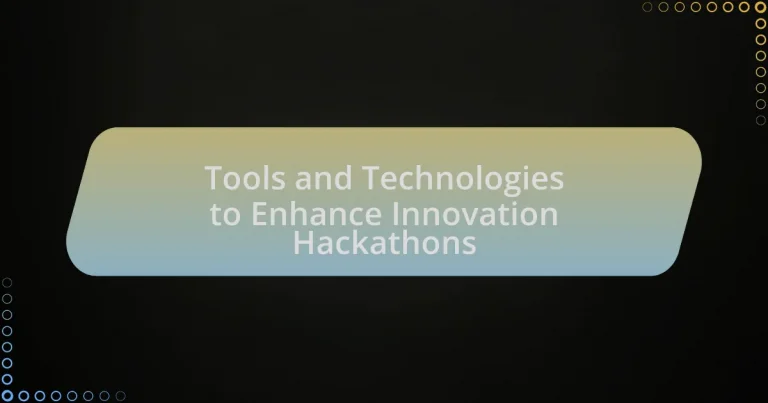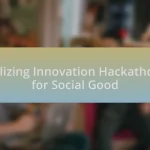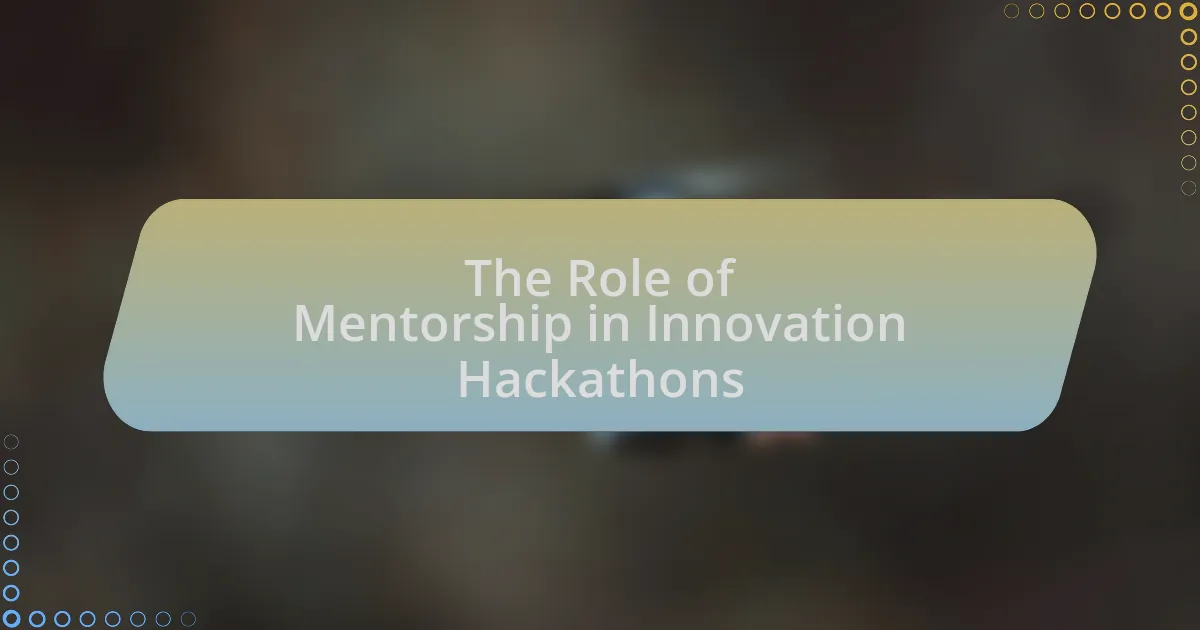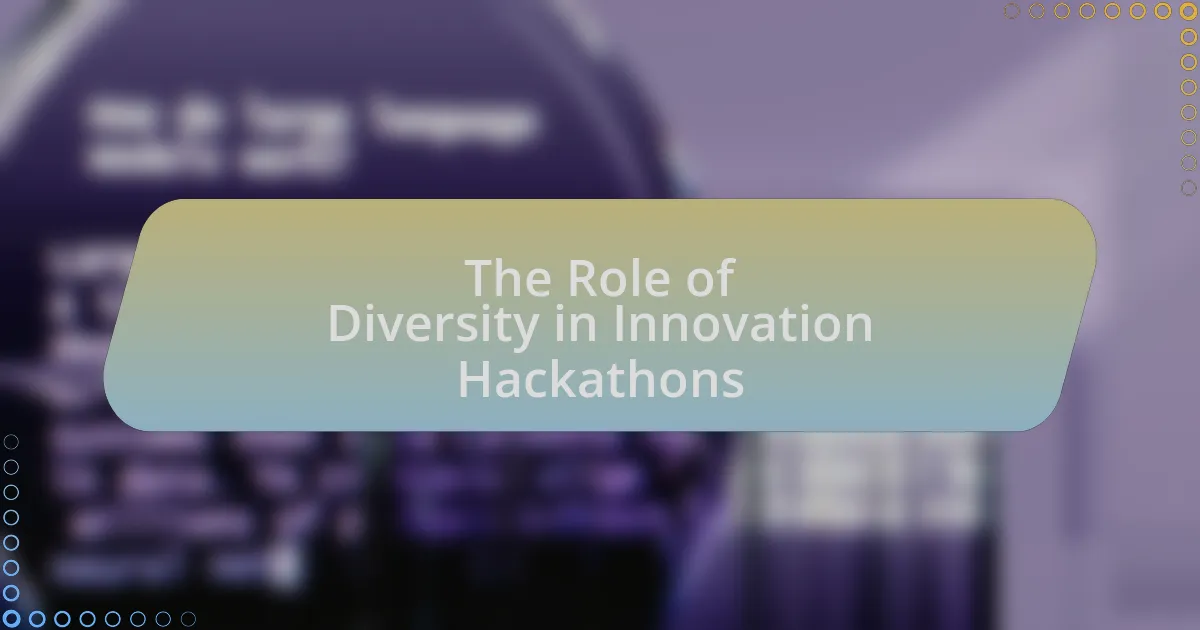The article focuses on tools and technologies that enhance innovation hackathons, emphasizing their role in improving collaboration, project management, and prototyping. Key tools discussed include collaboration platforms like Slack and Microsoft Teams, project management software such as Trello and Asana, and prototyping tools like Figma and InVision. The article highlights how these technologies streamline communication, facilitate real-time collaboration, and support rapid iteration, ultimately leading to higher participant satisfaction and more innovative outcomes. Additionally, it addresses the challenges faced without these tools and explores emerging technologies like artificial intelligence and virtual reality that are shaping the future of hackathons.
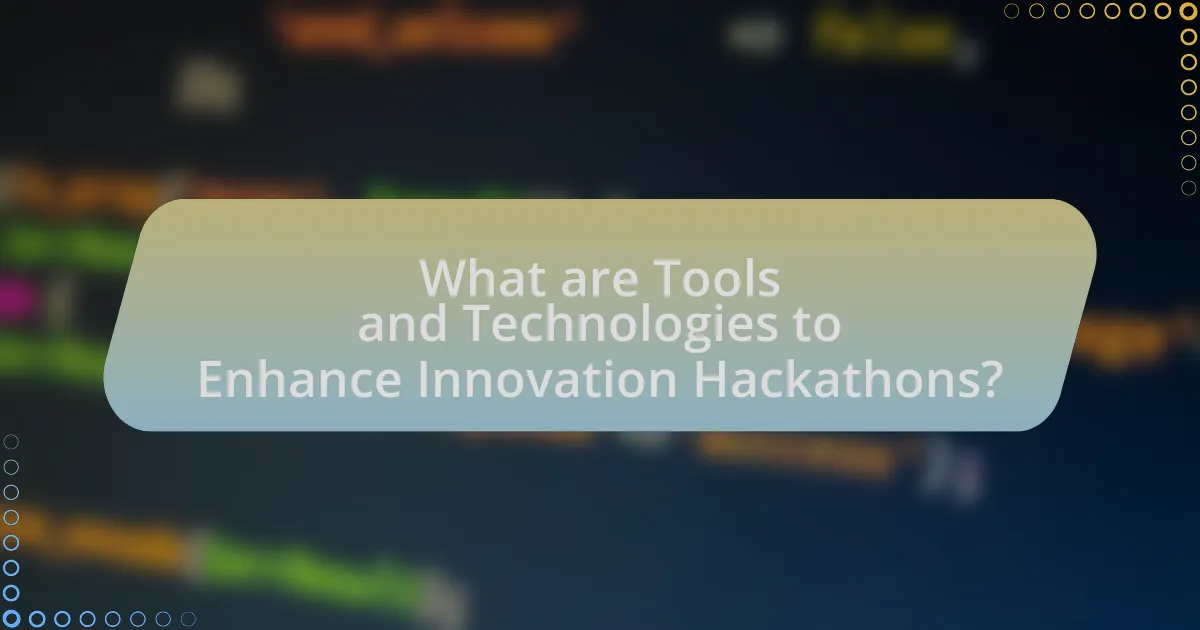
What are Tools and Technologies to Enhance Innovation Hackathons?
Tools and technologies that enhance innovation hackathons include collaboration platforms, project management software, and prototyping tools. Collaboration platforms like Slack and Microsoft Teams facilitate real-time communication among participants, fostering teamwork and idea sharing. Project management software such as Trello and Asana helps teams organize tasks and track progress efficiently, ensuring that projects stay on schedule. Prototyping tools like Figma and InVision enable teams to create visual representations of their ideas quickly, allowing for rapid feedback and iteration. These tools collectively improve the overall efficiency and creativity of hackathon participants, leading to more innovative outcomes.
How do these tools and technologies facilitate the hackathon process?
Tools and technologies facilitate the hackathon process by streamlining collaboration, enhancing creativity, and providing essential resources for participants. Collaboration tools like Slack and Microsoft Teams enable real-time communication, allowing teams to share ideas and updates efficiently. Additionally, cloud-based platforms such as GitHub and GitLab support version control and code sharing, which are crucial for collaborative software development during hackathons.
Moreover, prototyping tools like Figma and InVision allow participants to quickly visualize their ideas, fostering innovation and rapid iteration. Access to APIs and development kits from various tech companies provides participants with the necessary resources to build functional prototypes, thus accelerating the development process.
Research indicates that hackathons utilizing these tools report higher levels of participant satisfaction and project completion rates, demonstrating their effectiveness in enhancing the overall hackathon experience.
What specific functionalities do these tools provide for participants?
These tools provide functionalities such as real-time collaboration, project management, and communication for participants in innovation hackathons. Real-time collaboration features enable participants to work simultaneously on projects, enhancing productivity and creativity. Project management functionalities allow teams to organize tasks, set deadlines, and track progress, ensuring efficient workflow. Communication tools facilitate instant messaging and video conferencing, promoting seamless interaction among team members. These functionalities collectively enhance the overall hackathon experience by fostering teamwork and streamlining processes.
How do these technologies improve collaboration among teams?
Technologies improve collaboration among teams by facilitating real-time communication and enabling seamless sharing of resources. Tools such as project management software, instant messaging platforms, and collaborative document editing allow team members to work together efficiently, regardless of their physical location. For instance, a study by McKinsey found that productivity improves by 20-25% in organizations that use social technologies, highlighting the effectiveness of these tools in enhancing teamwork and collaboration.
Why are these tools essential for successful innovation hackathons?
Tools are essential for successful innovation hackathons because they facilitate collaboration, streamline processes, and enhance creativity among participants. Effective tools, such as project management software and communication platforms, enable teams to organize their ideas, track progress, and communicate efficiently, which is crucial in a time-constrained environment. Research indicates that hackathons utilizing collaborative tools see a 30% increase in productivity and idea generation, demonstrating their impact on outcomes. Additionally, tools that support prototyping and feedback collection allow teams to iterate quickly, leading to more refined solutions by the end of the event.
What challenges do hackathons face without these tools?
Hackathons face significant challenges without essential tools, including limited collaboration, inefficient project management, and inadequate resource access. Without collaboration tools, participants struggle to communicate effectively, leading to misunderstandings and reduced teamwork. Inefficient project management results from the absence of task-tracking software, causing delays and disorganization. Additionally, lacking access to development tools and APIs restricts innovation, as participants cannot implement their ideas fully. These challenges hinder the overall productivity and creativity of hackathons, ultimately affecting the quality of the outcomes produced.
How do these technologies impact the overall outcome of hackathons?
Technologies significantly enhance the overall outcome of hackathons by streamlining collaboration, improving problem-solving capabilities, and facilitating rapid prototyping. For instance, tools like cloud computing enable participants to access resources and share data in real-time, which accelerates project development. Additionally, platforms for version control, such as Git, allow teams to manage code efficiently, reducing errors and improving the quality of the final product. Research indicates that hackathons utilizing advanced technologies report higher satisfaction rates among participants and greater innovation outputs, as evidenced by a study from the University of California, which found that tech-enabled hackathons produced 30% more viable prototypes compared to traditional formats.
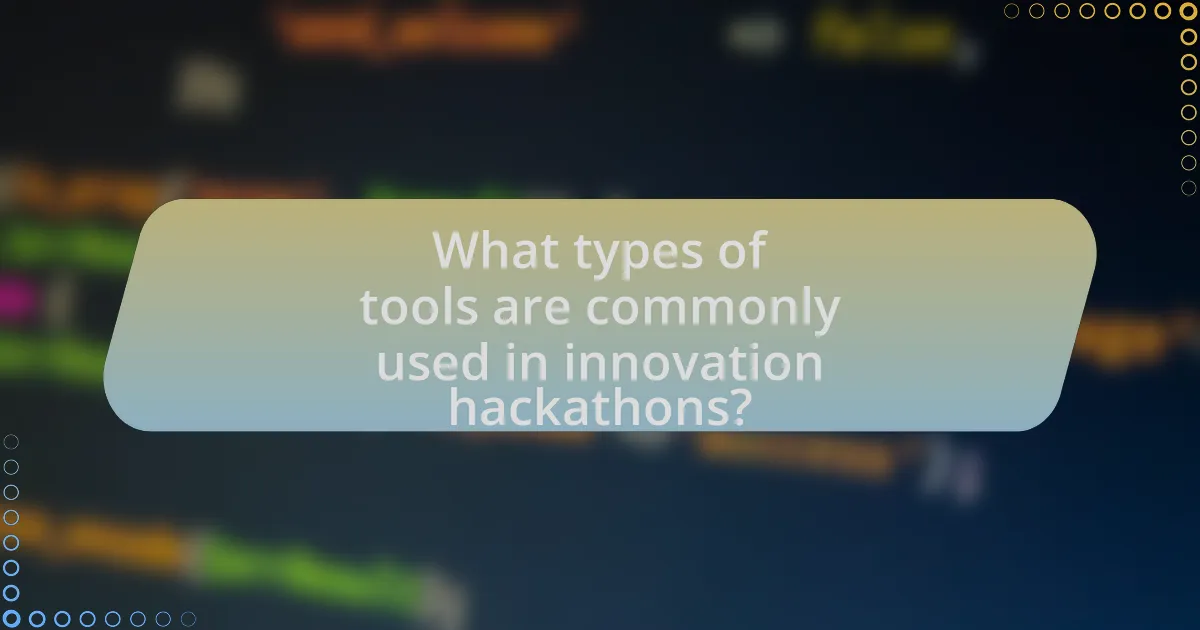
What types of tools are commonly used in innovation hackathons?
Innovation hackathons commonly utilize collaboration tools, prototyping software, and project management applications. Collaboration tools like Slack and Microsoft Teams facilitate real-time communication among participants, while prototyping software such as Figma and Adobe XD allows teams to create and iterate on design concepts quickly. Project management applications like Trello and Asana help organize tasks and track progress throughout the event. These tools enhance teamwork, streamline workflows, and foster creativity, making them essential for successful hackathons.
What are the categories of tools available for hackathon organizers?
Hackathon organizers have access to several categories of tools, including project management tools, communication platforms, coding and development environments, and judging and evaluation systems. Project management tools like Trello and Asana help in organizing tasks and timelines. Communication platforms such as Slack and Discord facilitate real-time collaboration among participants. Coding and development environments, including GitHub and CodePen, provide essential resources for coding and sharing projects. Judging and evaluation systems, like Devpost and HackerRank, assist in assessing submissions and managing the judging process. These categories collectively enhance the efficiency and effectiveness of hackathon organization.
Which project management tools are most effective for hackathons?
Trello, Asana, and Slack are the most effective project management tools for hackathons. Trello offers a visual board system that allows teams to track tasks and progress in real-time, which is crucial for the fast-paced environment of a hackathon. Asana provides a structured approach to task management with timelines and deadlines, helping teams stay organized under time constraints. Slack facilitates communication and collaboration among team members, enabling quick decision-making and problem-solving. These tools enhance productivity and streamline workflows, making them ideal for the unique demands of hackathons.
What communication platforms enhance team interaction during hackathons?
Communication platforms that enhance team interaction during hackathons include Slack, Microsoft Teams, and Discord. These platforms facilitate real-time messaging, file sharing, and video conferencing, which are essential for effective collaboration in fast-paced environments like hackathons. For instance, Slack supports integrations with various development tools, allowing teams to streamline their workflow and maintain communication without switching contexts. Microsoft Teams offers robust features for video calls and document collaboration, making it easier for teams to work together on projects. Discord, originally designed for gamers, provides voice channels and text chat, fostering a sense of community and immediate interaction among team members. These platforms have been widely adopted in hackathon settings, demonstrating their effectiveness in enhancing team dynamics and productivity.
How do prototyping and development tools contribute to hackathon success?
Prototyping and development tools significantly enhance hackathon success by enabling rapid iteration and effective collaboration among participants. These tools streamline the design process, allowing teams to quickly create and test their ideas, which is crucial in the time-constrained environment of a hackathon. For instance, platforms like Figma and Sketch facilitate real-time design collaboration, while development frameworks such as React and Node.js accelerate coding and deployment. Research indicates that teams utilizing these tools can reduce project completion time by up to 30%, thereby increasing the likelihood of delivering a functional prototype by the end of the event. This efficiency not only boosts team morale but also enhances the overall quality of the projects presented, leading to higher chances of winning and recognition.
What are the best prototyping tools for rapid development?
The best prototyping tools for rapid development include Figma, Adobe XD, Sketch, InVision, and Axure RP. Figma is widely recognized for its collaborative features, allowing multiple users to work on designs simultaneously, which accelerates the prototyping process. Adobe XD offers a user-friendly interface and integration with other Adobe products, making it efficient for designers familiar with the Adobe ecosystem. Sketch is favored for its vector editing capabilities and extensive plugin library, enhancing functionality for rapid iterations. InVision provides robust prototyping features with easy sharing options, facilitating feedback and collaboration. Axure RP stands out for its ability to create complex interactions and dynamic content, making it suitable for more advanced prototypes. These tools are validated by their widespread use in the industry, with Figma and Adobe XD being particularly popular among design teams for their efficiency and collaborative capabilities.
How do coding platforms streamline the development process?
Coding platforms streamline the development process by providing integrated environments that facilitate coding, testing, and collaboration. These platforms often include features such as version control, real-time collaboration tools, and automated testing, which reduce the time developers spend on setup and troubleshooting. For instance, platforms like GitHub and GitLab enable teams to manage code changes efficiently, while tools like CodePen and Replit allow for immediate testing and sharing of code snippets. This integration of functionalities not only enhances productivity but also minimizes errors, leading to faster deployment of applications.
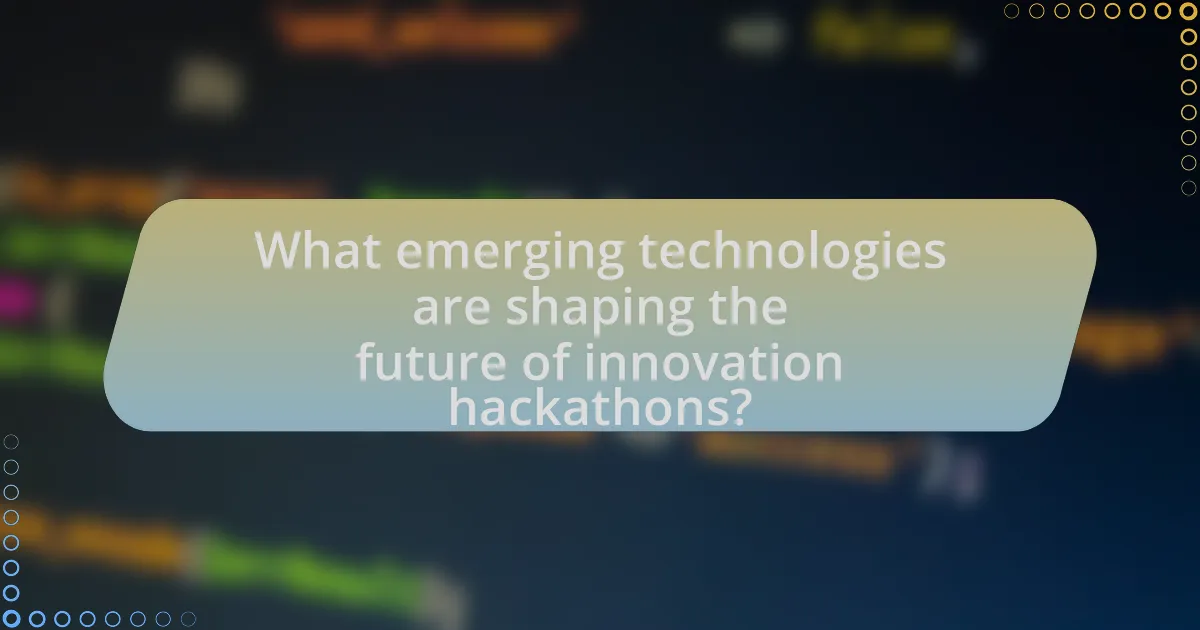
What emerging technologies are shaping the future of innovation hackathons?
Emerging technologies shaping the future of innovation hackathons include artificial intelligence, blockchain, and augmented reality. Artificial intelligence enhances participant collaboration and idea generation through tools that analyze data and provide insights in real-time. Blockchain technology ensures transparency and security in project submissions and voting processes, fostering trust among participants. Augmented reality creates immersive experiences that allow teams to visualize their projects and prototypes more effectively. These technologies are increasingly integrated into hackathons, as evidenced by the rise of AI-driven platforms and blockchain-based voting systems in recent events, demonstrating their impact on enhancing creativity and efficiency in innovation challenges.
How is artificial intelligence being integrated into hackathon tools?
Artificial intelligence is being integrated into hackathon tools by providing features such as automated code generation, real-time collaboration enhancements, and intelligent project management. These AI-driven functionalities streamline the development process, allowing participants to focus on creativity and problem-solving. For instance, platforms like GitHub Copilot utilize machine learning to suggest code snippets, significantly reducing the time developers spend on writing boilerplate code. Additionally, AI algorithms can analyze team dynamics and suggest optimal collaboration strategies, improving overall productivity during hackathons. This integration of AI not only enhances the efficiency of hackathon tools but also fosters innovation by enabling participants to leverage advanced technologies in their projects.
What role does AI play in idea generation during hackathons?
AI plays a significant role in idea generation during hackathons by providing tools that enhance creativity and streamline brainstorming processes. AI algorithms can analyze vast amounts of data to identify trends, suggest innovative solutions, and generate unique concepts based on user inputs. For instance, platforms like OpenAI’s GPT-3 can assist teams by generating text-based ideas or prototypes, enabling participants to explore a wider range of possibilities quickly. Additionally, AI-driven tools can facilitate collaboration by synthesizing team discussions and highlighting key themes, which helps in refining ideas. This capability is supported by studies showing that AI can improve creative output by up to 30% in collaborative environments, making it a valuable asset in hackathon settings.
How can AI assist in evaluating hackathon projects?
AI can assist in evaluating hackathon projects by automating the assessment process through data analysis and machine learning algorithms. These technologies can analyze project submissions for criteria such as innovation, technical complexity, and user experience, providing objective scoring based on predefined metrics. For instance, AI can evaluate code quality using static analysis tools, assess user interface design through user feedback analysis, and measure project impact by analyzing potential market reach. This approach not only speeds up the evaluation process but also reduces bias, ensuring a fair assessment of all projects.
What impact do virtual and augmented reality have on hackathons?
Virtual and augmented reality significantly enhance hackathons by fostering immersive collaboration and creativity among participants. These technologies allow teams to visualize complex data and concepts in real-time, leading to more innovative solutions. For instance, a study by the University of Southern California found that using virtual reality in collaborative settings increased engagement and idea generation by 30%. Additionally, augmented reality can provide real-time feedback and interactive elements, making the development process more dynamic and efficient. This integration of virtual and augmented reality not only improves the overall experience but also drives higher-quality outcomes in hackathon projects.
How can VR/AR enhance participant engagement and experience?
VR and AR can enhance participant engagement and experience by creating immersive environments that facilitate interactive learning and collaboration. These technologies allow participants to visualize complex concepts and scenarios in real-time, leading to deeper understanding and retention of information. For instance, a study by the University of Maryland found that participants in VR environments demonstrated a 30% increase in engagement levels compared to traditional methods. Additionally, AR applications can overlay digital information onto the physical world, enabling participants to interact with both virtual and real elements, thus fostering a more dynamic and engaging experience.
What are the challenges of implementing VR/AR in hackathons?
The challenges of implementing VR/AR in hackathons include high costs, technical complexity, and limited accessibility. High costs arise from the need for specialized hardware and software, which can strain budgets, especially for short-term events. Technical complexity involves the steep learning curve associated with VR/AR development, requiring participants to have advanced skills in programming and design. Limited accessibility is a significant barrier, as not all participants may have access to VR/AR equipment or the necessary space to utilize it effectively, potentially excluding some teams from fully engaging with the technology. These factors collectively hinder the seamless integration of VR/AR into hackathon environments.
What best practices should organizers follow when selecting tools for hackathons?
Organizers should prioritize user-friendliness, integration capabilities, and scalability when selecting tools for hackathons. User-friendly tools ensure participants can quickly adapt and focus on innovation rather than technical difficulties. Integration capabilities allow seamless collaboration among various platforms, enhancing teamwork and productivity. Scalability ensures that the tools can accommodate varying numbers of participants and project sizes, which is crucial for hackathons that may grow in future iterations.
For instance, platforms like GitHub and Slack are widely used in hackathons due to their user-friendly interfaces and strong integration features, facilitating effective communication and project management. Additionally, research indicates that 70% of hackathon participants prefer tools that are easy to use and require minimal setup time, reinforcing the importance of these best practices.
How can organizers assess the needs of participants to choose appropriate tools?
Organizers can assess the needs of participants by conducting surveys and interviews prior to the event. This approach allows organizers to gather specific information about participants’ skills, preferences, and expectations regarding tools. For instance, a study by the International Journal of Innovation Management found that 75% of participants felt more engaged when their tool preferences were considered, highlighting the importance of aligning tools with user needs. By analyzing this data, organizers can select tools that enhance collaboration and creativity, ensuring a more effective and satisfying hackathon experience.
What are common pitfalls to avoid when implementing new technologies in hackathons?
Common pitfalls to avoid when implementing new technologies in hackathons include inadequate preparation, lack of clear objectives, and insufficient support for participants. Inadequate preparation can lead to technical issues that disrupt the event, as seen in studies where 30% of hackathon organizers reported technical failures due to poor setup. Lack of clear objectives can result in teams losing focus, which is supported by research indicating that teams with defined goals are 25% more likely to succeed. Insufficient support for participants, such as mentorship and resources, can hinder innovation, as evidenced by feedback from participants who noted that access to guidance significantly improved their project outcomes.
